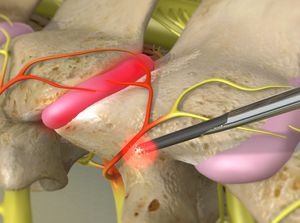A medial branch radiofrequency neurotomy is a procedure performed on patients who are suffering from pain caused by inflammation of certain joints of the spine. When the joints are inflamed, the soft tissue of these structures swells up which compresses the nerves that surround them.
The procedure specifically targets the medial branch nerves which are small nerves that exit from the facet joints of the spine. These are nerves that transmit pain signals from the facet joints through the spinal cord and to the brain.
Diagnosing and Managing Medial Branch Nerve Pathology
In order to diagnose and manage medial branch nerve involvement, one has to determine if this is where the pain is coming from. This is performed as follows:
- Performing a medial branch nerve block – here, a local anesthetic agent is injected near the small medial nerves that pass through a specific facet joint. If the patient experiences a significant amount of pain relief following the procedure, then that facet joint is confirmed to be the affected area giving rise to the patient’s symptoms.
- A medial branch radiofrequency neurotomy can then be performed after the medial branch nerve block confirms the involvement of these nerve structures.

What is a Medial Branch Radiofrequency Neurotomy
Also referred to as radiofrequency ablation, medial branch radiofrequency neurotomy is a type of injection procedure where the tip of the probe is inserted close to the affected nerve branches and is heated.
The heating process does not involve heating an element but rather applying a current to the probe which causes it to vibrate. The vibrations cause the tip of the probe to become heated and this is used to numb the affected nerve.
The heated probe interrupts pain signaling from the facet joint to the brain while still preserving other functions of the nerves such as muscle strength and normal sensation. Therefore, the patient will experience less pain while still maintaining normal functioning of the nerve.
The medial branch nerves do control small muscles in the neck and middle and lower back, but the loss of nerve tissue function in these areas has not been proven to be detrimental to the patient.
Success Rate
The success rates for medial branch radiofrequency neurotomy vary but the following findings have been demonstrated through clinical studies:
- 30 to 50 percent of patients who undergo the procedure will experience a significant amount of pain relief for as long as up to two years.
- Of the remaining numbers, around 50 percent will achieve some pain relief for a shorter period of time.
- The success rates for the procedure being done to alleviate pain coming from the cervical (neck) region are greater than for any other areas of the spine.
- If done properly, the procedure will generally provide pain relief for between 9 and 14 months, but sometimes even longer. However, at some point thereafter the ablated nerve will regenerate and the pain may return.
Patients may then have a repeat ablation done of the affected nerve in order to achieve similar pain relief.
